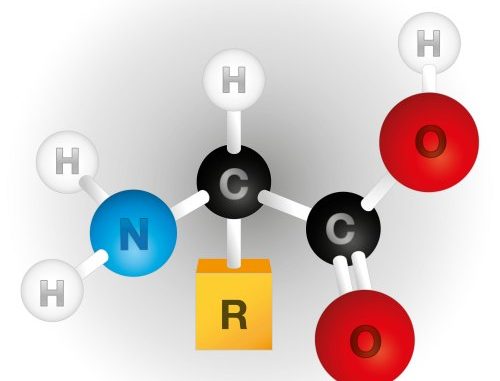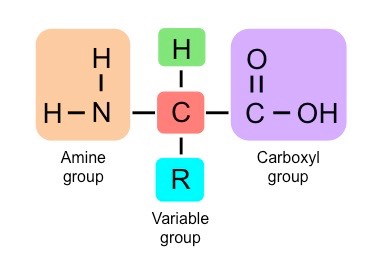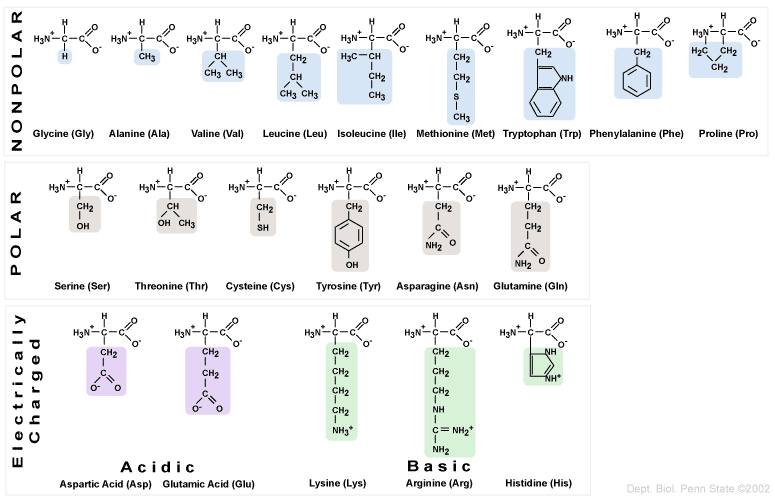
Amino acids: Characteristics and Classification of amino acids
- Amino acids are carboxylic acid in which α-carbon is attached to the amino group as well as it is attached to R- (alkyl) group. They are the basic unit of proteins.

- There are 20 types of amino acids which are coded by the gene of vertebrate but large numbers of modified (non-standard) amino acids are found in proteins.
Characteristics of amino acids:
- Amino acids are basic units of protein.
- All amino acids have at least one acidic carboxylic acid (-COOH) group and one basic amino (-NH2) group.
- Amino acids are colorless, crystalline solid
- They are soluble in water and insoluble in organic solvent
- Only L- form of amino acids are found in Proteins in human body. If D-form is present, it is converted into l-form by enzymes in liver.
- More than 300 amino acids are found in nature but only 20 amino acids are standard and present in protein because they are coded by gene.
- Other non-standard amino acids are modified aminoacids and called non-protein amino acids.
Some examples of Modified amino acids:
- 4-hydroxyproline: synthesized from proline
- 5-hydroxylysine: synthesized from lysine
- Gamma-aminobutyric acid (GABA): synthesized from glutamic acid
- Gamm-carboxylglutamate: synthesized from glutamic acid
- Desmosine: synthesized from lysine
Classification of amino acids
I. Classification on the basis of R-group
II. Classification on the basis of nutrition
III. Classification on the basis of Catabolism
I. Classification of amino acids on the basis of R-group
 1. Group A : Hydrophobic amino acids
1. Group A : Hydrophobic amino acids
- Amino acids in which R-group is non-polar
- (GAVLIMPPT); Glycine, Alanine, Valine, leucine, Isoleucine, Methionine, Phenylalanine, Proline, Tryptophan
2. Group B: Hydrophilic, uncharged amino acids
- Amino acids in which R-group is polar, hydrophilic but uncharged
- CSTGAT; Cystein, Serine, Threonine, Glutamine, Asparagine, Tyrosine
3. Group C: acidic amino acids
- Amino acids in which R-group is acidic or negatively charged
- GA; Glutamic acid and Aspartic acid
4. Group D: basic amino acids
- Amino acids in which R-group is basic or positively charged
- LAH; Lysine, Arginine, Histidine
II. Classification of amino acids on the basis of Nutrition:
1. Essential amino acids:
- These amino acids are not synthesized in cells of human beings, so these should be essentially present in diet.
- PVTTIMHALL; Phenylalanine, Valine, Threonine, Tryptophan, Isoleucine, Methionine, Histidine, Arginine*, Leucine, Lysine
- Arginine is conditional amino acids (Essential for infants, non essential for adults)
2. Non essential amino acids:
- These aminoacids can be synthesized in body, so need not be included in diet.
- (GASCAGAGTP); Glycine, Alanine, Serine, Cysteine, Asparagine, Glutamine, Aspartic acid, Glutamic acid, Tyrosine, Proline
III. Classification of amino acids on the basis of Catabolism
1. Glucogenic amino acids:
- These aminoacids serves as precursors gluconeogenesis for glucose formation
- GAMD (Glycine, Alanine, methionine, Aspartic acid).
2. Ketogenic amino acids:
- These aminoacids breakdown to form ketone bodies.
- Leucine and Lysine
3. Both glucogenic and ketogenic amino acids:
- These amino acids breakdown to form precursors for both ketone bodies and glucose.
- Isoleucine, Phenylalanine, Tryptophan and tyrosine
